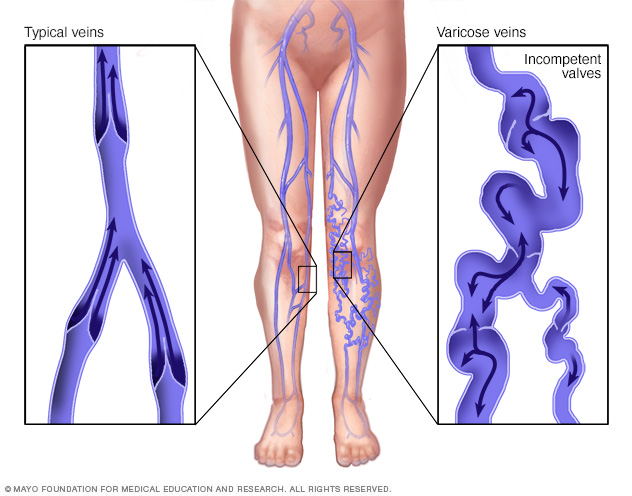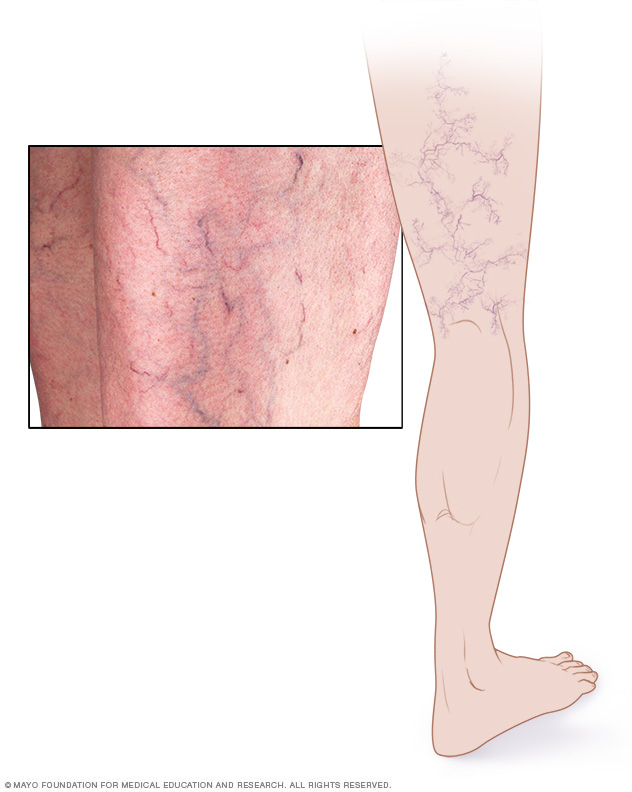Varicose veins
Overview
Varicose veins are bulging, enlarged veins. Any vein that is close to the skin's surface, called superficial, can become varicosed. Varicose veins most often affect the veins in the legs. That's because standing and walking increase the pressure in the veins of the lower body.
For many people, varicose veins are simply a cosmetic concern. So are spider veins, a common, mild form of varicose veins. But varicose veins can cause aching pain and discomfort. Sometimes they lead to more-serious health problems.
Treatment involves exercising, raising legs when sitting or lying down, or wearing compression stockings. A procedure may be done to close or remove veins.

Veins return blood from the rest of the body to the heart. To return blood to the heart, the veins in the legs must work against gravity. Weakened valves, also called incompetent valves, within the veins might cause varicose veins. The weakened valves let blood pool in the veins instead of traveling to the heart. When blood pools in the veins, the veins become larger, making them show under the skin.
Symptoms
Varicose veins might not cause pain. Symptoms of varicose veins include:
- Veins that are dark purple, blue or the same color as the skin. Depending on skin color, these changes may be harder or easier to see.
- Veins that look twisted and bulging. They often look like cords on the legs.
When there are painful symptoms of varicose veins, they might include:
- An achy or heavy feeling in the legs.
- Burning, throbbing, muscle cramping and swelling in the lower legs.
- Worse pain after sitting or standing for a long time.
- Itching around one or more of the veins.
- Changes in skin color around a varicose vein.
Spider veins are like varicose veins, but they're smaller. Spider veins are found closer to the skin's surface and might look like a spider's web.
Spider veins occur on the legs but also can be found on the face. They vary in size and often look like a spider's web.
When to see a doctor
If you worry about how your veins look and feel and self-care measures haven't helped, see your healthcare professional.

Spider veins appear as thin, red lines or as weblike networks of blood vessels on the surface of the skin. Spider veins, a mild form of varicose veins, most often appear on the legs and feet.
Causes
Weak or damaged valves can lead to varicose veins. Arteries carry blood from the heart to the rest of the body. Veins return blood from the rest of the body to the heart. To return blood to the heart, the veins in the legs must work against gravity.
Muscles tighten in the lower legs to act as pumps. Vein walls help blood return to the heart. Tiny valves in the veins open as blood flows toward the heart, then close to stop blood from flowing backward. If these valves are weak or damaged, blood can flow backward and pool in the veins, causing the veins to stretch or twist.
Risk factors
The two main risk factors for varicose veins are:
- Family history. If other family members have varicose veins, there's a greater chance you will too.
- Obesity. Being overweight puts added pressure on veins.
Other things that might increase the risk of varicose veins include:
- Age. Aging causes wear and tear on the valves in the veins that help control blood flow. Over time, that wear causes the valves to allow some blood to flow back into the veins, where it collects.
- Sex. Women are more likely to get the condition. Hormones tend to relax vein walls. So changes in hormones before a menstrual period or during pregnancy or menopause might be a factor. Hormone treatments, such as birth control pills, might increase the risk of varicose veins.
- Pregnancy. During pregnancy, the blood volume in the body increases. This change supports the growing baby but also can make the veins in the legs bigger.
- Standing or sitting for long periods of time. Movement helps blood flow.
Complications
Complications of varicose veins are rare. They can include:
- Ulcers. Painful ulcers can form on the skin near varicose veins, mostly near the ankles. A discolored spot on the skin often begins before an ulcer forms. See your healthcare professional right away if you think you have a leg ulcer.
- Blood clots. Sometimes, veins deep within the legs get larger. They might cause leg pain and swelling. Seek medical help for ongoing leg pain or swelling. This can mean a blood clot.
- Bleeding. Rarely, veins close to the skin burst. This mostly causes only minor bleeding. But it needs medical help.
- Leg swelling. Longtime varicose veins can cause the legs to swell.
Prevention
Getting better blood flow and muscle tone might lower the risk of having varicose veins. The same ways you treat the discomfort from varicose veins can help prevent them. Try the following:
- Don't wear high heels or tight stockings, other than compression stockings.
- Change how you sit or stand often.
- Eat a high-fiber, low-salt diet.
- Exercise.
- Raise your legs when sitting or lying down.
- Keep a healthy weight.
Diagnosis
To diagnose varicose veins, a healthcare professional examines you. This includes looking at your legs while you're standing to check for swelling. You might be asked to describe the pain and aching in your legs.
Tests
To diagnose varicose veins, a healthcare professional might use a test called a venous Doppler ultrasound of the leg. It's a painless test that uses sound waves to look at blood flow through the valves in the veins. A leg ultrasound can help find a blood clot.
Treatment
Treatment for varicose veins may include self-care measures, compression stockings, and surgeries or procedures. Procedures to treat varicose veins are often done as outpatient procedures. That means you most often go home on the same day.
Ask your insurer if varicose vein treatment is a covered cost. If varicose vein treatment is done only to make your legs look better, this is called cosmetic. Your insurance might not cover it.
Self-care
Things you can do to help ease the pain of varicose veins include exercising, raising your legs when sitting or lying down, or wearing compression stockings. Self-care measures also might keep the veins from getting worse.
Compression stockings
Wearing compression stockings all day is often the first approach to try. The stockings squeeze the legs, helping veins and leg muscles move blood. The amount of pressure varies by type and brand.
You can find compression stockings at most pharmacies and medical supply stores. You also can get prescription-strength stockings. Insurance might cover the prescription ones if your varicose veins cause symptoms.
Surgeries or other procedures
If self-care steps and compression stockings don't work, or varicose veins are more severe, a healthcare professional might suggest surgery or other procedures:
-
Sclerotherapy. A healthcare professional injects the varicose veins with a solution or foam that scars and closes them. In a few weeks, treated varicose veins should fade.
Some veins might need shots more than once. You don't need to be asleep for sclerotherapy. It can be done in a healthcare professional's office.
- Laser treatment. Laser treatment sends strong bursts of light onto the varicose vein. This makes the vein slowly fade until it can't be seen. No cuts or needles are used.
- Catheter-based procedures using radiofrequency or laser energy. This procedure is the treatment most used for larger varicose veins. A healthcare professional puts a thin tube called a catheter into an enlarged vein. Radiofrequency or laser energy heats the tip of the catheter. As the catheter is taken out, the heat destroys the vein by causing it to cave in and seal shut.
High ligation and vein stripping. This procedure involves first tying off a varicose vein before the place where it joins a deep vein. The next step is removing the varicose vein through small cuts. This is an outpatient procedure for most people.
Removing the vein won't keep blood from flowing in the leg. That's because veins deeper in the leg take care of the larger amounts of blood.
- Ambulatory phlebectomy (fluh-BEK-tuh-me). A healthcare professional removes smaller varicose veins through tiny pricks in the skin. Only the parts of the leg that are being pricked are numbed in this outpatient procedure. Most often there's not much scarring.
Lifestyle and home remedies
Try these lifestyle and home remedies for varicose veins:
- Get regular exercise. Walking is a great way to help blood flow in the legs. Your healthcare professional can suggest a good activity level for you.
- Manage weight. Losing excess pounds takes pressure off the veins.
- Avoid salt. Follow a low-salt diet to prevent swelling caused when the body holds in water.
- Choose proper footwear. Don't wear high heels. Low-heeled shoes work calf muscles more. This is better for your veins.
- Don't wear tight clothes. Tight clothes around your waist, legs or groin can reduce blood flow.
- Raise your legs. To improve blood flow in your legs, take a few short breaks daily to raise the legs above the level of the heart. For instance, lie down with your legs resting on three or four pillows. You also can raise the foot of the bed six inches.
- Change position often. Don't sit or stand for long periods. Moving helps blood flow.
Preparing for an appointment
Your healthcare professional needs to look at your bare legs and feet to diagnose varicose veins and find the treatment that might be best for your condition.
Your primary health professional might suggest that you see a doctor who specializes in vein conditions, called a phlebologist or vascular surgeon, or a doctor who treats skin conditions, called a dermatologist or dermatology surgeon.
Here are ways to prepare for your appointment.
What you can do
Make a list of:
- Your symptoms, including any that may not seem linked to varicose veins, and when they began.
- Important personal information, including a family history of varicose veins or spider veins.
- All medicines, vitamins or supplements you take, including doses.
- Questions to ask your healthcare professional.
Some basic questions to ask include:
- What's the most likely cause of my symptoms?
- What else could cause my varicose veins?
- What tests will I need?
- What treatment do you suggest?
- How can I best manage varicose veins along with other health conditions I have?
- Do I need to restrict any activities?
- Are there any brochures or other printed materials I can have? What websites do you suggest?
What to expect from your doctor
Your health professional is likely to ask you questions, including:
- When did you notice the varicose veins?
- Do you have pain? If so, how bad is it?
- What, if anything, seems to make your symptoms better?
- Does anything seem to make your symptoms worse?
What you can do in the meantime
Before your appointment, you can begin self-care.
- Try not to stand or sit in one position for a long time.
- Raise your legs when you're seated.
- Don't wear shoes that don't fit well or tight socks or stockings, other than compression stockings.
Last Updated Feb 6, 2024
© 2024 Mayo Foundation for Medical Education and Research (MFMER). All rights reserved. Terms of Use